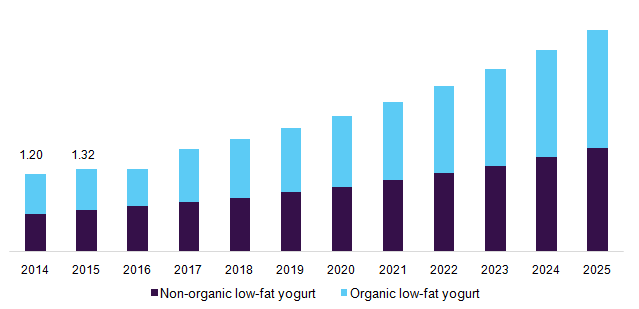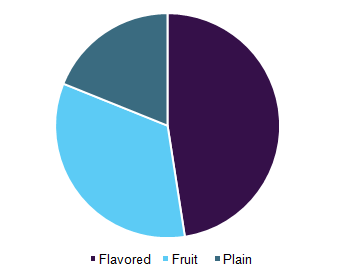- Home
- »
- Consumer F&B
- »
-
Low-Fat Yogurt Market Size, Share, Global Trends Industry Report 2025GVR Report cover
![Low-Fat Yogurt Market Report]()
Low-Fat Yogurt Market Analysis By Origin (Non-Organic, Organic), By Type (Flavored, Fruit, Plain), By Region (North America, Europe, Asia Pacific, Central & South America, MEA), And Segment Forecasts, 2018 - 2025
- Report ID: GVR-1-68038-895-4
- Number of Report Pages: 90
- Format: PDF, Horizon Databook
- Historical Range: 2014 - 2015
- Forecast Period: 2017 - 2025
- Industry: Consumer Goods
Industry Insights
The global low-fat yogurt market size was worth USD 11.65 billion in 2016. Increasing production of low-fat dairy items coupled with various health benefits associated with the consumption of yogurt is expected to boost the industry demand. Technological advancements and rising process automation in the industry are also anticipated to propel industry growth.
U.S. low-fat yogurt market revenue by origin, 2014 - 2025 (USD Billion)

Globally, changing consumer preferences regarding the consumption of organic, tasty, and healthy dairy food are expected to drive the market demand. Rising production and consumption of organic flavored products in the European countries are expected to boost the overall industry.
The U.S. market was valued at USD 1.45 billion in 2016 and is predicted to ascend at a CAGR of 10.2% from 2017 to 2025. Major companies present in the market are involving themselves in new and organic product innovation owing to the growing popularity of such products.
Established players present in the global market are also concentrating on developing new innovative processes for reducing costs and enhancing the output. The production of low-fat dairy items is driven by the Western European and U.S. dairy companies. The players present in these regions, such as Nestle and Danone, are expanding their manufacturing facilities globally.
Origin Insights
Non-organic low-fat yogurt is prepared from artificial flavors, fruits, sweeteners, thickeners, additives, inactive cultures, and stabilizers. Yogurt that is prepared from milk, but which does not adhere to the standards of dairy farming practices set by the various governments globally is also classified as non-organic. These products have a longer shelf life and are relatively cheaper as compared to organic items.
These products contain artificial stabilizers, additives, and sweeteners, which is a major drawback for the growth of the segment. Rising health concerns and increasing awareness regarding the consumption of non-organic dairy items are expected to be major challenges for the industry. According to various studies conducted regarding the consumption of conventional food items, it has been proved that the products prepared from artificial sources cause various health problems.
Flavors, fruits, milk, sweeteners, and stabilizers used for making yogurt are obtained from natural sources. Organic low-fat yogurt also uses live bacterial cultures for the fermentation process. Growing awareness regarding the consumption of synthetic and conventional products coupled with rising health problems associated with their consumption such as blood pressure, diabetes, Crohn’s disease, and many others are the major factor boosting the organic low-fat yogurt market.
The regional and global companies operating in the organic yogurt segment are involved in research & development activities for enhancing their product portfolio. In addition, these companies are also developing advanced technologies for producing innovative products to address the varied demands of consumers. Globally, various government organizations are focusing on promoting the benefits related to the consumption of organic yogurt and other dairy products.
Type Insights
Globally, three types of low-fat yogurt are available in the stores, flavored, fruit, and plain. The flavored segment dominated the global demand in 2016, with over 47% of the total market share. Chocolate, vanilla, coffee, and mint are some of the common flavors added for improving the aroma, taste, and texture of the end product. Various health benefits associated with the consumption of organic flavored items are expected to aid in boosting its demand globally. Flavored products are gaining popularity in the North American region. Their consumption in the regular diet is highly preferred by the population in the region.
Growing demand for processed low-fat dairy items in China & India is expected to boost the Asian market over the forecast period. The global dairy players are focusing on extending their regional presence in the Asia Pacific by opening more production and distribution units. The demand for natural flavored food items is rising globally. Market players associated with the production of these items are trying to develop new products to gain a competitive edge.
Global low-fat yogurt market revenue by type, 2016 (%)

Fruit low-fat yogurt is among the most popular dairy products. The product is gaining popularity, especially in the Asia Pacific region, owing to the effectiveness of its nutraceuticals. Some of the fruit-flavored low-fat yogurt types available in stores include strawberry, apple, mango, cherry, blueberry, peach, and banana. For manufacturing fruit-based low-fat yogurt, fruits are added to the milk products in the form of fruit preparation (which is industrially manufactured from whole fruit or pieces or pulps, and on rare occasions also from fruit puree or fruit concentrate). In the process, naturally obtained pectins are also added as thickening agents for improving texture and appearance. The global players along with various research institutions are also trying to make different types of low-fat yogurt from papaya and banana pulp.
Regional Insights
Europe and North America together dominated the overall market in 2016. Together, these regions held around 55% of the total industry share. Over the past two decades, the production of yogurt has been globalized, owing to the economic growth in emerging and developing countries. The demand for the product is mainly driven by the global players present in Western European countries. Favorable government regulations and the removal of milk quota in the European region are expected to boost the regional demand in the coming years.
The North American market is mainly driven by the rising consumption of low-fat dairy items in the U.S. A large number of regional players are present in the U.S. These players are trying to introduce new flavors to increase their market share.
The Asia Pacific is emerging as a potential market with a considerable increase in the consumption of dairy items in China, Japan, and India. Rising disposable income coupled with the increasing number of consumers preferring organic products is expected to boost the demand in the region. New Zealand and Australia are among the major suppliers of processed milk in the region. The rising export of dairy products from these countries is anticipated to propel industry growth.
Competitive Insights
The market is highly competitive in nature with the presence of several market players. The players present in the market are investing in research & development activities for innovating new and developed processes. Some of the global players operating in the industry include General Mills, Inc.; Danone, Inc.; and Nestle S.A. Some regional players present in the market are Rainy Lanes Dairy Foods Ltd.; Springfield Creamery (Nancy's); Jalna Dairy Foods; Gopala; Wallaby Yogurt Company; Byrne Dairy; and Tillamook Dairy Co-Op.
Report Scope
Attribute
Details
Base year for estimation
2016
Actual estimates/Historical data
2014 - 2015
Forecast period
2017 - 2025
Market representation
Revenue in USD million and CAGR from 2017 to 2025
Regional scope
North America, Europe, Asia Pacific, Central & South America, Middle East & Africa
Country scope
U.S., UK, France, China, Japan, India, Brazil
Report coverage
Revenue forecast, company share, competitive landscape, growth factors and trends
15% free customization scope (equivalent to 5 analyst working days)
If you need specific market information, which is not currently within the scope of the report, we will provide it to you as a part of customization
Segments covered in the reportThis report forecasts revenue growth at the global, regional, and country levels and provides an analysis of the industry trends in each of the sub-segments from 2014 to 2025. For the purpose of this study, Grand View Research has segmented the global low-fat yogurt market on the basis of type, origin, and region:
-
Origin Outlook (Revenue, USD million; 2014 - 2025)
-
Non-Organic Low-Fat Yogurt
-
Organic Low-Fat Yogurt
-
-
Type Outlook (Revenue, USD million; 2014 - 2025)
-
Flavored
-
Fruit
-
Plain
-
-
Regional Outlook (Revenue, USD million; 2014 - 2025)
-
North America
-
The U.S.
-
-
Europe
-
UK
-
France
-
-
Asia Pacific
-
China
-
Japan
-
India
-
-
Central & South America
-
Brazil
-
-
Middle East & Africa
-
Share this report with your colleague or friend.
![gvr icn]()
NEED A CUSTOM REPORT?
We can customize every report - free of charge - including purchasing stand-alone sections or country-level reports, as well as offer affordable discounts for start-ups & universities. Contact us now
![Certified Icon]()
We are GDPR and CCPA compliant! Your transaction & personal information is safe and secure. For more details, please read our privacy policy.
We are committed towards customer satisfaction, and quality service.
"The quality of research they have done for us has been excellent."





